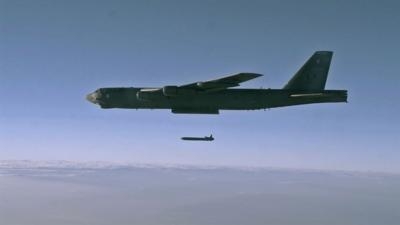Aircraft Launched Out Of Minot Air Force Base To Test Range In Utah
Air Force B-52H Stratofortress aircrews recently tested three unarmed AGM-86B air-launched cruise missiles, demonstrating the bomber force’s ability to configure, load, fly and deliver the nation’s only nuclear cruise missile.

The B-52H aircrews departed Minot Air Force Base, North Dakota, for the Utah Test and Training Range, about 80 miles west of Salt Lake City, and launched the unarmed ALCMs during three separate sorties.
The ALCM is a key air component of the nuclear triad, providing the nation a strategic capability to assure our allies and deter potential adversaries. It provides a clear, visible and tailorable deterrent effect, and denies geographic sanctuaries to potential adversaries.
The AGM-86B is designed to deliver a nuclear payload on target, destroying it on impact. As a standoff weapon, the ALCM can be launched from outside the combat area, allowing aircrews to strike distant targets with a high degree of accuracy without exposing themselves to potentially deadly enemy fire. A B-52H can carry six ALCMs on each of the two externally mounted pylons and eight internally on a rotary launcher, giving the B-52H a maximum capacity of 20 missiles.
The ALCM sustainment program is managed by the Air Force Nuclear Weapons Center and the tests were conducted under Air Force Global Strike Command’s Nuclear Weapon System Evaluation Program, part of the Air Force’s ongoing effort to test weapons systems in training missions and prepare aircrews for future mission requirements. The integrated test team also included personnel, assets and aircraft from AFGSC's 5th Bomb Wing at Minot AFB; its 2nd BW at Barksdale AFB, Louisiana; and Air Combat Command's 53rd Wing at Eglin AFB, Florida.
The ALCM was initially designed with a 10-year life span but has been in use for about 35 years, largely due to successful sustainment programs. While the current ALCM remains a safe, secure, effective and viable nuclear capability, it faces increasing sustainment and operational challenges against emerging threats as it continues to age. The Long Range Stand Off weapon is being developed to replace the ALCM, which the Air Force expects to start fielding by 2030.
“The LRSO will be a critical element of the United States’ nuclear deterrence strategy, but we must continue to support the ALCM program until it is fielded and these recent tests are clear indicators of the ALCM’s effectiveness and reliability,” said Maj. Gen. Scott Jansson, the AFNWC commander and Air Force program executive officer for strategic systems.
The LRSO weapon system will be a cost-effective force multiplier for B-52, B-2 Spirit and B-21 Raider to credibly deter adversaries and assure U.S. allies of our deterrent capabilities. Currently in source selection, up to two LRSO contracts are expected to be awarded in the fourth quarter of fiscal year 2017.
About 200 personnel in AFNWC’s Air-Delivered Capabilities Directorate deliver, sustain and support air-delivered nuclear weapon systems. The directorate is located at Kirtland AFB and oversees locations at Tinker AFB, Oklahoma; Eglin AFB, Florida; Joint Base San Antonio, Texas; Ramstein AB, Germany; Robins AFB, Georgia; and Wright-Patterson AFB, Ohio. The ALCM sustainment program is managed at the Tinker AFB location.
The AFNWC is responsible for synchronizing all aspects of nuclear materiel management on behalf of Air Force Materiel Command in direct support of AFGSC. Headquartered at Kirtland AFB, the center has about 1,000 personnel assigned at 17 locations worldwide.
(Image provided with USAF news release)
 ANN's Daily Aero-Term (05.29.25): Terminal Radar Service Area
ANN's Daily Aero-Term (05.29.25): Terminal Radar Service Area ANN's Daily Aero-Term (05.30.25): Very High Frequency (VHF)
ANN's Daily Aero-Term (05.30.25): Very High Frequency (VHF) Aero-News: Quote of the Day (05.30.25)
Aero-News: Quote of the Day (05.30.25) Airborne 05.23.25: Global 8000, Qatar B747 Accepted, Aviation Merit Badge
Airborne 05.23.25: Global 8000, Qatar B747 Accepted, Aviation Merit Badge ANN's Daily Aero-Linx (05.30.25)
ANN's Daily Aero-Linx (05.30.25)



